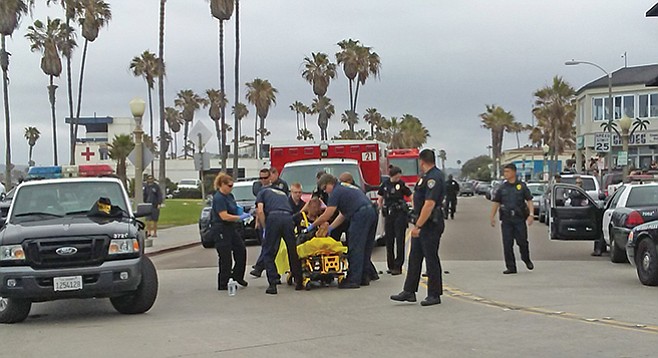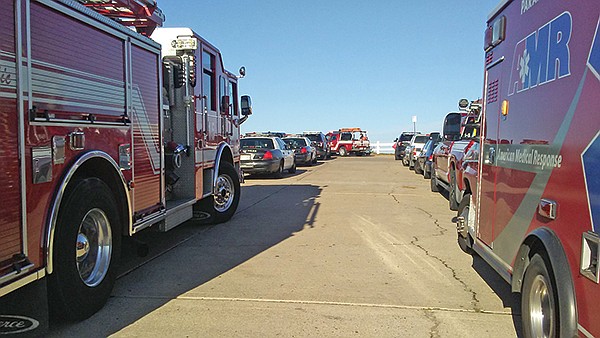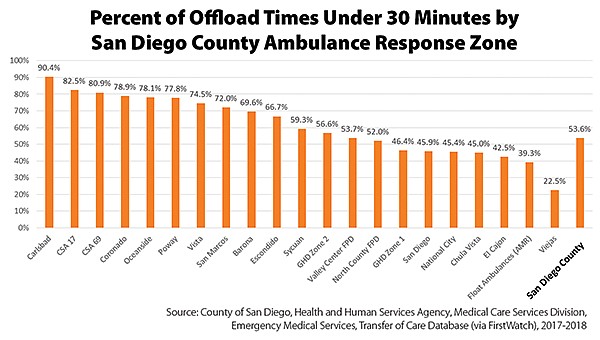 Facebook
Facebook
 X
X
 Instagram
Instagram
 TikTok
TikTok
 Youtube
Youtube

In October 2015, American Medical Response acquired Rural Metro, one of the largest emergency (ambulance) providers in the nation. In October of 2017, the medical response company renegotiated with the City of San Diego a rate increase for the cost of transportation. According to one emergency medical technician willing to speak anonymously, “To say it’s a mess in an understatement.”

The mess referred to is a lack of available ambulances, overworked employees, and long delays in transporting victims to the hospital, while also creating a shortage of fire engines and emergency personnel in some areas.
“We are playing Russian roulette with our citizens,” Todd Barry told me. “I just wanted to bring this to light. It needs to be heard and [American Medical Response] needs to be held accountable.”
Barry has been a firefighter for 30 years, 15 of those years out of the Ocean Beach station, and a paramedic 10 of those years.

“To make up for the shortage [of ambulances], the city fire department has been sending two engines/trucks to all medical calls that don’t have a medic unit assigned,” he explained in early January. “The impact is huge for the fire department, and for the citizens of San Diego…. [American Medical Response] ambulances use fire stations to do crew changes, but once their shift starts you never see them back at the station; they run non-stop…many of their paramedics are overworked, doing 12-hour shifts running from call-to-call. The last thing you want is tired and overworked paramedics transporting you to the hospital…. I have no idea why this is happening or know when it will stop. One call is too many not to have an ambulance available.”
In December of 2016, NBC 7 San Diego investigated “level zero” — when no ambulances are available for 911 emergency calls — and noted that American Medical Response missed the city-mandated response times in six of the eight medical-response zones in San Diego for the month of October (2016). The company was fined $291,000.
From January 1, 2017, through June 30, 2017, AMR/Rural Metro accrued non-compliance penalties in the amount of $75,500.
On January 22, 2018, an ambulance driver in Indiana was killed after falling asleep and crashing. “It’s just a matter of time before it happens here,” Barry says.
I spoke to multiple American Medical Response employees. Employee One, explained the situation: “We have multiple ambulances shut down — at least 20. It’s gotten to the point where they’ve actually cut multiple ambulances out of the system, leaving us very short staffed. I think we are 31 or 32 medics short…. Add to that, call volume is up — 911 calls have increased significantly and it’s having a domino effect on everyone.... We’ve had patients on the gurney sitting in front of the hospital for up to four or five hours because hospitals don’t have any beds to move them to.”
(Employee One noted that life-threatening injuries “are pushed forward” and don’t have to wait on gurneys.)
This wait time is officially referred to as “off load” time. According to the San Diego County Transfer of Care report, dated December 2017, data separated by San Diego County ambulance-response zones indicates that the average offload time for San Diego County in total is 28 minutes, with 53.6 percent of patients offloaded in under 30 minutes. American Medical Response has an average offload time of 35 minutes.
“[American Medical Response] can’t even get people to apply for jobs anymore. Paramedic pay starts at about $14 an hour; they can make more money bagging groceries at Costco…. There are two shifts, 12 hours and 24 hours…. It’s to the point where we start our shift and may not see the station [for breaks], rarely sleep, have no chance to even eat…. We get no breaks and literally run from one call to the other.”
Employee One took an informal survey among coworkers and found that out of the 200 responses received, only 12 of them said they have not worked while sick or injured. “We have crew members working sick, working hurt…working 36, 48, 60, and 72 straight hours with little breaks. We have 20 paramedic units they don’t have staffing for. Response time for us should be 12 minutes, but if you were to call 911, it could take 25 to 30 minutes to get to you — if you’re having a stroke or cardiac issue, or you were hurt significantly where time is critical, you may not make it to the hospital....
“Everyone that I know is starting to look for jobs elsewhere. They keep pushing the crews, who are at their wits’ end…. I’ve been doing this for 21 years and have never seen it this bad. For a municipal system, it’s so backward at times we can’t even get supplies…. I actually carry a cache of hidden supplies so I can take care of my patients; they run out of oxygen almost weekly.”
Another emergency medical technician, Employee Two, told me: “I wouldn’t want to call 911 with this system, I love my job…been with Rural since 2012, but even working 80 hours a week, I still wasn’t earning enough, so I cut back my hours and got a second job. Like I said, I love being an EMT, but with the hours and pay, it’s not attracting new hires.”
“The situation is beyond belief,” another ten-year veteran (Employee Three) told me. “The [emergency medical] system in San Diego is so broken.... I can literally pick and choose what shifts I want to work because they are so understaffed…. Last weekend [January 28th] there was only one ambulance available — almost every weekend is like that…units are pulled from North County to cover calls in downtown San Diego.”
In December 2017, attorneys from Pope, Berger, Williams & Reynolds began meeting with emergency medical technicians to represent them in a lawsuit that’s been filed in the U.S. District Court (Southern District of California). Plaintiffs contend that emergency medical technicians working for Rural Metro Ambulance et al. (including American Medical Response) were not given ten-minute rest periods, as required by law, because “they were not relieved of all duties at any time during their shift.” It is alleged “that ambulance-crew members were on call during their entire shifts and that they were required to keep their pagers and radios on at all times and to comply with 60- or 120-second ‘out-the-chute’ times upon receiving a service call.”
A hearing is scheduled in federal court on March 16 to determine whether the case will be classified as a class-action matter.
“This is the worst I’ve seen it in five years,” Employee Three added. “There are less ambulances on the street than there were five years ago. It’s mind-boggling what’s going on, and the citizens of San Diego should be informed of this…. On a side note, we just had a second EMT have to be treated for irregular heartbeat because of drinking energy drinks just to function at work.”
On February 2nd, a fourth emergency medical technician messaged me: “It is horrible today. We are responding from Scripps La Jolla to the airport and another unit was responding from Rancho Bernardo to the Border…. Don’t get hurt or sick right now, it’ll take a long time to get an ambulance…. A lot of us are afraid to talk about it because we love our jobs and don’t want to be fired.”
Asked for comment, Madeleine D. Baudoin, American Medical Response’s government and public affairs manager responded, “We are working diligently to recruit more employees and bolster our ability to add staff. So far this year, we have hired 21 caretakers into the City of San Diego system, including eight new paramedics and 13 EMTs with more to follow.”


In October 2015, American Medical Response acquired Rural Metro, one of the largest emergency (ambulance) providers in the nation. In October of 2017, the medical response company renegotiated with the City of San Diego a rate increase for the cost of transportation. According to one emergency medical technician willing to speak anonymously, “To say it’s a mess in an understatement.”

The mess referred to is a lack of available ambulances, overworked employees, and long delays in transporting victims to the hospital, while also creating a shortage of fire engines and emergency personnel in some areas.
“We are playing Russian roulette with our citizens,” Todd Barry told me. “I just wanted to bring this to light. It needs to be heard and [American Medical Response] needs to be held accountable.”
Barry has been a firefighter for 30 years, 15 of those years out of the Ocean Beach station, and a paramedic 10 of those years.

“To make up for the shortage [of ambulances], the city fire department has been sending two engines/trucks to all medical calls that don’t have a medic unit assigned,” he explained in early January. “The impact is huge for the fire department, and for the citizens of San Diego…. [American Medical Response] ambulances use fire stations to do crew changes, but once their shift starts you never see them back at the station; they run non-stop…many of their paramedics are overworked, doing 12-hour shifts running from call-to-call. The last thing you want is tired and overworked paramedics transporting you to the hospital…. I have no idea why this is happening or know when it will stop. One call is too many not to have an ambulance available.”
In December of 2016, NBC 7 San Diego investigated “level zero” — when no ambulances are available for 911 emergency calls — and noted that American Medical Response missed the city-mandated response times in six of the eight medical-response zones in San Diego for the month of October (2016). The company was fined $291,000.
From January 1, 2017, through June 30, 2017, AMR/Rural Metro accrued non-compliance penalties in the amount of $75,500.
On January 22, 2018, an ambulance driver in Indiana was killed after falling asleep and crashing. “It’s just a matter of time before it happens here,” Barry says.
I spoke to multiple American Medical Response employees. Employee One, explained the situation: “We have multiple ambulances shut down — at least 20. It’s gotten to the point where they’ve actually cut multiple ambulances out of the system, leaving us very short staffed. I think we are 31 or 32 medics short…. Add to that, call volume is up — 911 calls have increased significantly and it’s having a domino effect on everyone.... We’ve had patients on the gurney sitting in front of the hospital for up to four or five hours because hospitals don’t have any beds to move them to.”
(Employee One noted that life-threatening injuries “are pushed forward” and don’t have to wait on gurneys.)
This wait time is officially referred to as “off load” time. According to the San Diego County Transfer of Care report, dated December 2017, data separated by San Diego County ambulance-response zones indicates that the average offload time for San Diego County in total is 28 minutes, with 53.6 percent of patients offloaded in under 30 minutes. American Medical Response has an average offload time of 35 minutes.
“[American Medical Response] can’t even get people to apply for jobs anymore. Paramedic pay starts at about $14 an hour; they can make more money bagging groceries at Costco…. There are two shifts, 12 hours and 24 hours…. It’s to the point where we start our shift and may not see the station [for breaks], rarely sleep, have no chance to even eat…. We get no breaks and literally run from one call to the other.”
Employee One took an informal survey among coworkers and found that out of the 200 responses received, only 12 of them said they have not worked while sick or injured. “We have crew members working sick, working hurt…working 36, 48, 60, and 72 straight hours with little breaks. We have 20 paramedic units they don’t have staffing for. Response time for us should be 12 minutes, but if you were to call 911, it could take 25 to 30 minutes to get to you — if you’re having a stroke or cardiac issue, or you were hurt significantly where time is critical, you may not make it to the hospital....
“Everyone that I know is starting to look for jobs elsewhere. They keep pushing the crews, who are at their wits’ end…. I’ve been doing this for 21 years and have never seen it this bad. For a municipal system, it’s so backward at times we can’t even get supplies…. I actually carry a cache of hidden supplies so I can take care of my patients; they run out of oxygen almost weekly.”
Another emergency medical technician, Employee Two, told me: “I wouldn’t want to call 911 with this system, I love my job…been with Rural since 2012, but even working 80 hours a week, I still wasn’t earning enough, so I cut back my hours and got a second job. Like I said, I love being an EMT, but with the hours and pay, it’s not attracting new hires.”
“The situation is beyond belief,” another ten-year veteran (Employee Three) told me. “The [emergency medical] system in San Diego is so broken.... I can literally pick and choose what shifts I want to work because they are so understaffed…. Last weekend [January 28th] there was only one ambulance available — almost every weekend is like that…units are pulled from North County to cover calls in downtown San Diego.”
In December 2017, attorneys from Pope, Berger, Williams & Reynolds began meeting with emergency medical technicians to represent them in a lawsuit that’s been filed in the U.S. District Court (Southern District of California). Plaintiffs contend that emergency medical technicians working for Rural Metro Ambulance et al. (including American Medical Response) were not given ten-minute rest periods, as required by law, because “they were not relieved of all duties at any time during their shift.” It is alleged “that ambulance-crew members were on call during their entire shifts and that they were required to keep their pagers and radios on at all times and to comply with 60- or 120-second ‘out-the-chute’ times upon receiving a service call.”
A hearing is scheduled in federal court on March 16 to determine whether the case will be classified as a class-action matter.
“This is the worst I’ve seen it in five years,” Employee Three added. “There are less ambulances on the street than there were five years ago. It’s mind-boggling what’s going on, and the citizens of San Diego should be informed of this…. On a side note, we just had a second EMT have to be treated for irregular heartbeat because of drinking energy drinks just to function at work.”
On February 2nd, a fourth emergency medical technician messaged me: “It is horrible today. We are responding from Scripps La Jolla to the airport and another unit was responding from Rancho Bernardo to the Border…. Don’t get hurt or sick right now, it’ll take a long time to get an ambulance…. A lot of us are afraid to talk about it because we love our jobs and don’t want to be fired.”
Asked for comment, Madeleine D. Baudoin, American Medical Response’s government and public affairs manager responded, “We are working diligently to recruit more employees and bolster our ability to add staff. So far this year, we have hired 21 caretakers into the City of San Diego system, including eight new paramedics and 13 EMTs with more to follow.”
Comments